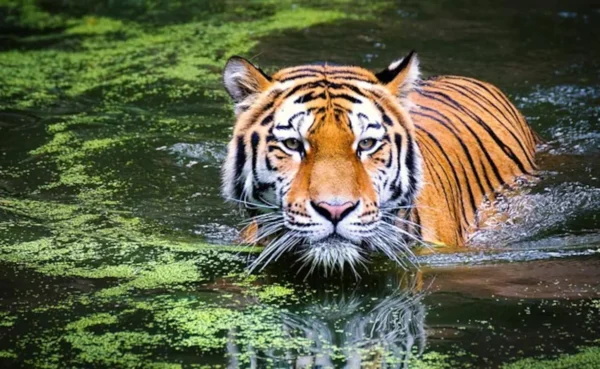
International Tiger Day: Celebrating Tigers
International Tiger Day, celebrated on July 29th each year, represents a global commitment to the conservation and expansion of wild tiger populations. Originally established during the Tiger Summit in Saint Petersburg, Russia, in 2010, the day has grown into an important event that not only raises awareness about the plight of the iconic big cat but also promotes the protection of their natural habitats. Tigers, once ranging widely across Asia, are now listed as an endangered species due to factors such as habitat loss, poaching, and human-wildlife conflict.
The day mobilizes international attention and echoes a collective stance towards doubling the number of wild tigers by the year established in the Tx2 goal, an agreement by tiger range countries to protect these majestic animals. Conservation efforts on International Tiger Day engage governments, wildlife organizations, and individuals through various initiatives and educational drives. Highlighting the importance of both tiger conservation and the broader implications for biodiversity and ecosystems underlines the need for continuous global efforts to ensure the survival of the tiger and the prosperity of our natural world.
Key Takeaways
- International Tiger Day emphasizes the global effort to conserve tigers and their habitats.
- Advocacy and public involvement play crucial roles in the success of tiger conservation.
- Despite challenges, there are dedicated initiatives aimed at reversing the decline of tiger populations.

The Significance of International Tiger Day
International Tiger Day, also known as World Tiger Day, is observed annually on July 29th to raise awareness for tiger conservation and to support efforts in doubling the number of wild tigers. It is a key initiative in emphasizing the importance of this iconic species and the protective measures needed to ensure its future survival.
History and Origin
International Tiger Day was established during the Saint Petersburg Tiger Summit in 2010, which was attended by representatives from 13 countries where tigers are native. Its inception was driven by the alarming fact that 97% of the wild tiger population had disappeared in the 20th century, with only about 3,000 left in the wild.
Objectives and Goals
Primary Objectives:
- Raise Awareness: To inform the public about the critical situation of tigers and the threats they face.
- Support Tiger Conservation: To gather support for tiger conservation efforts and to highlight the work of those on the frontlines.
The TX2 Goal:
A central goal announced alongside the establishment of International Tiger Day was the TX2 initiative, which aims to double the number of wild tigers by the year 2022. The initiative encourages global efforts in arresting the decline of tiger populations and promotes the recovery of their habitats.
Tiger Conservation Status
The global effort to conserve tigers, magnificent but threatened species, is a critical and ongoing struggle highlighted by serious declines yet punctuated with notable recoveries in certain areas.
Current Population Trends
The wild tiger population has experienced a significant decline over the past century, with current estimates suggesting fewer than 4,000 individuals remaining in the wild. According to the International Union for Conservation of Nature (IUCN), tigers are listed as Endangered, and some subspecies are critically endangered, teetering on the brink of extinction. Countries like India, Russia, Nepal, and Bhutan have varying population trends, with India home to the largest number of wild tigers.
Threats to Tigers
The threats to tigers are numerous and multifaceted. Primary threats include:
- Poaching: Illegal hunting for fur and body parts, highly valued in traditional medicine and for luxury goods.
- Habitat Loss: Expansion of human settlements and agriculture leads to the fragmentation and reduction of the tiger’s natural habitat.
- Human-Tiger Conflict: As habitats shrink, tigers and humans come into closer contact, often leading to fatal encounters for both parties.
Conservation Success Stories
Amidst the backdrop of declining populations, there are beacons of success:
- Project Tiger: Initiated by India in 1973, this government-led conservation effort has seen a resurgence in tiger numbers within its reserves.
- Tiger Range Countries’ Cooperation: All 13 tiger range countries have committed to TX2, the goal to double the wild tiger population by 2022.
Conservation programs are instrumental in stabilizing and, in some areas, increasing tiger numbers through concerted international cooperation and rigorous protection measures.

Conservation Efforts and Initiatives
In addressing the precarious state of tigers in the wild, various conservation efforts and initiatives have been undertaken globally. These strategies focus primarily on population monitoring, protection measures, and bolstering public awareness.
Global Actions
Since the inception of Global Tiger Day in 2010 at the Saint Petersburg Tiger Summit, concerted efforts to stabilize and increase the global tiger population have taken root. Central to these efforts is the TX2 initiative, a commitment backed by the World Wildlife Fund (WWF) and global partners to double the number of wild tigers by 2022. Progress is tracked through rigorous monitoring and international collaboration, aiming at a strong rebound from the approximately 3,900 tigers that remain in the wild.
- Key Global Initiatives:
- Collaboration for Global Tiger Recovery Program
- International funding and policy support through partnerships
Protection Strategies
Protection strategies are multi-faceted, focusing on both legal frameworks and on-the-ground actions. Anti-poaching units and tiger reserves play a significant role in providing safe habitats and reducing human-tiger conflicts. Countries with significant tiger populations have established networks of reserves and corridors to facilitate tiger movement and prevent habitat fragmentation. Additionally, the use of technology for monitoring tigers and enforcing anti-poaching laws has increased the effectiveness of these protective measures.
- Protection Frameworks:
- Establishment and expansion of tiger reserves
- Enhanced law enforcement and anti-poaching efforts
Awareness and Education
Education and public awareness campaigns are critical components in tiger conservation. They serve to raise awareness of the tiger’s plight and garner public support for conservation measures. Social media, eco-tourism, and conservation events like Global Tiger Day help in attaining a broad, engaged audience. These efforts aim not only to inform but also to foster a culture where communities living near tiger habitats understand and support conservation initiatives.
- Awareness Tools:
- Social media campaigns
- Eco-tourism programs linked with conservation education

World Tiger Day: Challenges in Tiger Conservation
Tiger conservation faces significant hurdles, including poaching and illegal wildlife trade, habitat destruction, and the effects of climate change. These issues compromise ongoing efforts to protect this endangered species and its genetic diversity, highlighting the urgency of addressing these challenges to prevent extinction.
Poaching and Illegal Wildlife Trade
Poaching remains one of the most immediate threats to tiger populations. Despite conservation efforts, the demand for tiger body parts for traditional medicine and other illegal trade purposes incentivizes poachers. This practice not only reduces the number of tigers in the wild but also threatens their genetic diversity.
- Primary drivers of poaching:
- High demand for tiger bone, skin, and other body parts
- High profits from illegal trade industry
Habitat Destruction and Fragmentation
Habitat loss and fragmentation due to infrastructure development and deforestation have a profound impact on tiger conservation. Tigers require large territories to thrive, but forests are being cleared for agriculture and urbanization. The reduction and splitting of habitats hinder the natural movement and breeding of tigers, limiting their ability to maintain healthy populations.
- Key factors contributing to habitat loss:
- Agricultural expansion
- Urbanization and infrastructure projects
Climate Change Effects
Climate change poses a long-term threat to tiger conservation, altering habitats and prey availability. Rising temperatures and changing weather patterns can lead to shifts in the ecosystems tigers inhabit, potentially leading to a loss of suitable habitats. These changes can also impact the availability and distribution of prey, further straining tiger populations.
- Climate change concerns:
- Changes in prey distribution
- Loss of habitat due to altered ecosystems
Advocacy and Public Involvement
Advocacy and public involvement are critical for the success of international efforts aimed at tiger conservation. By supporting these initiatives through various means, individuals can contribute significantly to ensuring the continued existence of this magnificent species.
Supporting Tiger Conservation
Donations and adopt a tiger programs are pivotal components of tiger conservation. Organizations such as the World Wide Fund for Nature (WWF) provide opportunities for individuals and corporations to support their efforts. Monetary support funnels into anti-poaching patrols, habitat preservation, and research.
- Raise Awareness: Education on tiger conservation issues is essential. Public campaigns and informational sessions help in sensitizing local communities and the global population about the plight of tigers.
- Support From Local Communities: Involving those living in proximity to tiger habitats ensures that conservation efforts are sustainable and culturally sensitive. Local support is often galvanized through community outreach programs.
Engaging Through Social Media
Social media serves as a powerful tool for public awareness and engagement.
- Celebrate International Tiger Day: Platforms like Facebook, Twitter, and Instagram help to amplify the message by encouraging users to share content related to International Tiger Day.
- Public Awareness Campaigns: These digital channels disseminate valuable information quickly, allowing for real-time participation and discussion among a broad audience.
Volunteering and Eco-Tourism
Volunteering opportunities in tiger reserves offer hands-on experience in conservation efforts. This type of involvement provides invaluable support to local operations and fosters a deep sense of connection with the cause.
- Eco-Tourism: By visiting tiger reserves responsibly, tourists provide economic support to regions that protect tigers, showing that wildlife is worth more alive and free.
- Ethical Programs: Visitors are encouraged to engage with programs that put the welfare of tigers and local communities at the forefront.

World Tiger Day: Frequently Asked Questions
International Tiger Day raises awareness and enhances efforts to protect tigers, focusing on conservation and habitats. Here are some of the most commonly raised questions regarding this important day.
What activities are commonly performed on International Tiger Day?
On International Tiger Day, organizations and communities engage in events such as fundraisers, educational seminars, global discussions, art exhibitions, and wildlife documentaries screenings to raise awareness about tiger conservation.
What is the historical significance behind the establishment of International Tiger Day?
International Tiger Day was established in 2010 during the Saint Petersburg Tiger Summit. The goal was to bring international attention to the severe decline of wild tiger numbers and to commit to doubling the tiger population by 2022.
Which country is currently known to host the largest population of wild tigers?
India currently hosts the largest population of wild tigers. The country has made significant strides in tiger conservation, leading to an increase in the wild tiger population in recent years.
Can you provide some interesting facts about tigers to share on International Tiger Day?
Tigers are the largest cat species with a recognizable orange coat and black stripes. Each tiger’s stripes are unique, similar to human fingerprints. Additionally, tigers can swim well and are mostly solitary except during the mating season and mother-cub bonding.
How can individual actions contribute to tiger conservation on International Tiger Day?
Individuals can contribute to tiger conservation by supporting tiger-friendly policies, donating to wildlife conservation organizations, participating in advocacy and awareness campaigns, and making lifestyle choices that reduce the impact on tiger habitats.
What are some educational resources or documentaries recommended for learning about International Tiger Day?
Recommended resources for learning about tigers and their conservation include the WWF (World Wildlife Fund) website and documentaries such as “Tiger: Spy in the Jungle” and “The Truth About Tigers,” which provide insight into the lives of tigers and efforts to save them.